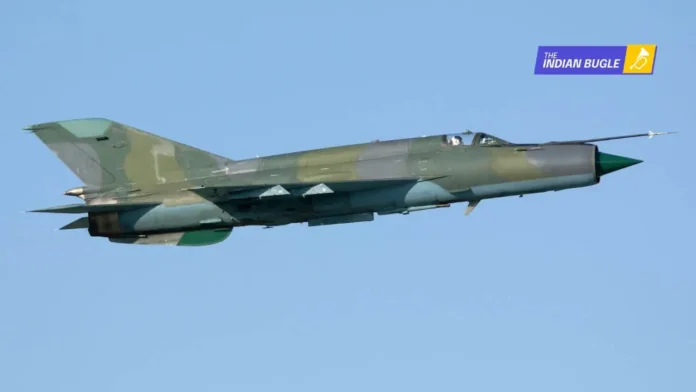For more than six decades, the MiG-21 has roared across Indian skies — small, swift, and formidable. Born in the Soviet Union as a lightweight supersonic interceptor, the delta-winged jet found a second home in India in the 1960s and went on to become the most recognisable face of the Indian Air Force. It taught generations of pilots the art of flying at twice the speed of sound, stood as a guardian of the nation’s borders, and participated in wars and conflicts that defined modern India. In September 2025, its farewell was marked with emotion and pride, as the IAF retired its last MiG-21 squadrons, closing an iconic era.
From Soviet Runways to Indian Skies
The MiG-21 first joined the Indian Air Force in 1963, a time when India sought a modern interceptor to counter high-altitude threats. What began as a fleet of just over a dozen aircraft expanded into more than 1,200 jets, many of them built under license in India. For decades, the IAF was even humorously nicknamed the “MiG Air Force,” given the sheer number of variants in operation. The jet’s original role as an interceptor quickly evolved into multi-role missions, including ground attack, reconnaissance, and pilot training.
A Warhorse in Combat
- 1965 and 1971 Wars: The MiG-21 quickly proved its worth in dogfights and air superiority missions against Pakistan. Its speed and climb gave India a decisive edge.
- Kargil War (1999): Despite being an older platform by then, MiG-21s were deployed for strike and support missions, showing their enduring versatility.
- Balakot and Beyond (2019): The MiG-21 Bison variant played a role in aerial skirmishes, even downing a modern F-16 — an extraordinary feat for a jet of its vintage.
- Patrols and Deterrence: Over decades, the MiG-21 flew countless sorties over India’s borders with both Pakistan and China, maintaining vigilance and quick response capability.
Its record across conflicts gave it the reputation of being a trusted guardian of Indian skies.
Why the MiG-21 Was Celebrated
- Supersonic Speed: One of the first fighters to break the Mach-2 barrier in Indian service.
- Rapid Climb & Agility: Ideal for interceptions, quick scrambles, and sudden airspace challenges.
- Versatility: Adapted from a pure interceptor into a multi-role fighter, capable of ground strikes and reconnaissance.
- Training Ground: Served as the first supersonic trainer for generations of Indian pilots, sharpening their skills for more advanced fighters.
- Numbers & Reach: Produced and inducted in large numbers, allowing India to cover vast borders and maintain an intimidating presence.
The Other Side of the Story
Yet, the MiG-21 was not without controversy.
- Safety Concerns: With aging airframes, the aircraft developed a troubling accident record, earning the grim nickname of the “flying coffin.” Many crashes were linked to technical faults, training gaps, or the sheer limitations of a decades-old design.
- Unforgiving Handling: Its high landing speeds and narrow cockpit visibility made it a challenging aircraft, especially for younger pilots.
- Short Range & Payload: Compared to modern fighters, its endurance and weapons load were limited.
- Aging Beyond Limits: Despite upgrades like the Bison variant, the platform eventually became outdated against fourth- and fifth-generation jets.
A Farewell with Honor
The final flypast in 2025 was more than a military ritual — it was a salute to a machine that shaped India’s air power and defence industry. The MiG-21 not only guarded India’s skies but also played a vital role in strengthening Indo-Russian defence ties and India’s indigenous aerospace production capabilities. Its last flight symbolised both pride in its service and relief at moving toward safer, more advanced aircraft like the Tejas LCA, Sukhoi Su-30MKI, and Rafale.
The Legacy in Summary — Achievements of the MiG-21
- Served the Indian Air Force for 62 years, the longest in its history.
- Fought and succeeded in multiple wars against Pakistan, including 1965, 1971, and Kargil.
- Downed modern adversaries, including a Pakistani F-16 in 2019, prove its mettle even in the 21st century.
- Produced in large numbers in India, boosting the nation’s defence industry.
- Trained thousands of pilots, making it the foundation of India’s fighter aviation.
- Adapted into upgraded versions like the MiG-21 Bison, extending its relevance far beyond original design limits.
The MiG-21 was never just a jet. It was a chapter of courage, sacrifice, and innovation. For generations of Indians, the distinctive delta wing and sharp nose cone will forever symbolise the grit of the Indian Air Force. Though its sonic boom will no longer echo in our skies, its story will remain etched in India’s military history as the tale of a warhorse that fought far beyond its years.
